Misión Nuestra Señora de la Purísima Concepción de Acuña
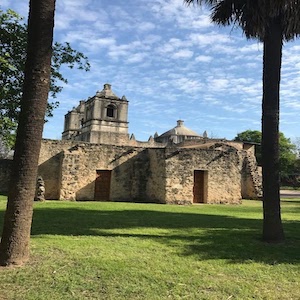
Annotation
The Spanish Crown claimed possession of vast territories throughout North, Central, and South America between the late-fifteenth and early and nineteenth centuries. The region that comprises the modern-day US Southwest served as borderlands between indigenous communities, and Spanish, French, and English colonies. It was not heavily populated with Spanish setters, but it did have military posts and missions. This church, the Misión Nuestra Señora de la Purísima Concepción de Acuña (located in San Antonio, Texas), was established in the mid-eighteenth century by Franciscan friars. It was constructed from local limestone by the indigenous people who lived and worked in the community. Although none of the exterior paint had survived, its interior still features several examples of eighteenth century frescoes. These decorations also would have been completed with indigenous labor. This source is part of the Historic Churches in the Southwestern US Source Collection.
Misión San José y San Miguel de Aguayo

Annotation
The San Jose Mission in San Antonio, Texas is one of the most complete complexes in the southwest. It was built in the mid-eighteenth century to evangelize approximately 300 indigenous people.Their tiny, two-room living quarters lined the interior walls of the complex. These individuals lived and worked there under the supervision of the church authorities. During the 1930s, the federal government funded an extensive renovation of the buildings. Today, it is a National Historic Park. The exterior stone walls of the complex are still standing. They fortified the settlement, and protected them from external attack. These tall walls created a clear boundary between the Spanish-controlled mission and the frontier region. The San Jose Mission also has one of the best preserved facades of all the remaining Spanish colonial churches in the US. Its baroque design and ornately carved figurative decoration were typical of Spanish churches built during the colonial period. However, such detailed decoration was less common in the remote, sparsely populated region of the Spanish frontier in North America. This source is part of the Historic Churches in the Southwestern US Source Collection.
Misión San Juan Capistrano

Annotation
The Misión San Juan Capistrano was a Spanish colonial complex intended to evangelize the native peoples. Although Spain claimed vast stretches of territory throughout the Americas, it struggled to produce enough bureaucrats to staff local governments. In some sparsely-populated regions like the modern-day US Southwest, the Crown granted missionaries the power to establish and supervise settlements among the indigenous people in order to convert them to Christianity. Francsiscan friars oversaw the San Juan Mission, which was built with indigneous labor in the mid-eighteenth century near modern-day San Antonio, Texas. It originally featured a church, a convent, and a granary.
Misión San Francisco de la Espada

Annotation
The Misión San Francisco de la Espada is one of the many churches that Spanish friars founded along the modern-day Southwestern United States. This area was a frontier-zone, bordering indigneous communities and British and French territories. It was established in the mid-eighteenth century near San Antonio, Texas to evangelize the native peoples. The stone complex originally featured a dam, granary, convent, chapel, and exterior walls. All of these structures were built with indigenous labor.
La Misión de Corpus Christi de San Antonio de la Ysleta del Sur

Annotation
Although the Spanish Crown claimed possession of the modern-day US borderlands, it was not able to send many settlers to the region. As a result, the priests and missionaries stationed there often took on both religious and government responsibilities. They became the spiritual, political, and economic overseers of the local indigenous populations. The missionaries sometimes physically moved these peoples so that they could more easily supervise, teach, and extract labor from them. This church, the La Misión de Corpus Christi de San Antonio de la Ysleta del Sur, was established in 1744 to convert the Tigua peoples to Christianity. Local disasters have required significant renovations to the original buildings. It belongs to the El Paso Mission Trail.
Nuestra Señora de la Concepción del Socorro

Annotation
The Nuestra Señora de la Concepción del Socorro was originally founded in the late-seventeenth century in modern-day New Mexico. It was moved in the eighteenth century to the El Paso region after local indigenous groups rebelled against Spanish rule, although flooding destroyed that structure soon after. The adobe church that stands today was built in the 1840s. However, the interior still features some of the original eighteenth-century decoration. For example, painted wooden beams, created by indigneous peoples who resided at the mission at the time, adorn the ceiling.
Misión San Elizario
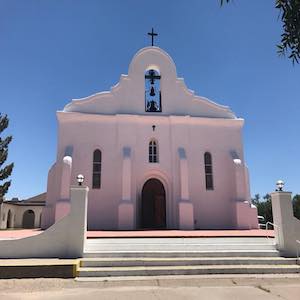
Annotation
Located in modern-day El Paso, Texas, the San Elizario Mission was originally established in 1789 by Spanish friars. The structure that stands today is considerably newer (1877) because a series of natural disasters destroyed previous buildings. Its name originates from the patron saint of the Spanish troops stationed in the region, San Elizario. During the eighteenth century, it operated as a frontier settlement, where the church officials and Spanish troops supervised local indigenous groups and kept guard against external threats. The objective of such missions was to evangelize the native peoples and also stake claim to the territory, which stood on the borderlands between Spanish, French, and English settlements, and indigenous-claimed regions.
Nuestra Señora de la Bahía del Espíritu Santo de Zúñiga

Annotation
This church was built as part of the larger project of indigneous evangelization, in which the Spanish Crown sent missionaries along the northern border of its North American possessions to establish churches and convert the natives. The Francsisan friars who governed this mission ministered to individuals of various backgrounds, including Aranama, Piguique, Manos de Perro, Tamique, Tawakoni, and Tonkawa. The original complex had a church, convent, living quarters, and granary, which the indigeinous people built. In the 1930s, the structure was restored by federal historical preservation projects.
Misión Santa Cruz de San Sabá

Annotation
The ruins of the Mission Santa Cruz de San Sabá are located in Menard, Texas. It once operated as a Spanish colonial church and military outpost. In the seventeenth and eighteenth centuries, Spanish friars established many such structures across the Southwestern United States. Each of these sites aimed to evangelize the local communities. During this period, the Lipan Apache became the target for these conversion efforts. The Santa Cruz de San Sabá was abandoned soon after it was built because of frequent attacks from an enemy of the Lipan Apache: the Comanche.
Misión Nuestra Señora del Refugio

Annotation
The Nuestra Señora del Refugio Mission was a Spanish colonial church complex built in the late-eighteenth century. By this period, Spanish friars had established dozens of similar communities throughout the modern-day US Southwest. At this time, this region functioned as a borderlands between Spain’s possessions and those of France and England. The objective of these missions was to convert the native peoples to Catholicism. The Karankawa peoples lived, worked, and worshiped there under the supervision of the church authorities. Like many other Spanish missions, it remained vulnerable to attacks from other indigenous groups in the area, such as the Comanche.
Misión San Agustin de Isleta

Annotation
This church complex, located near Albuquerque, New Mexico, once belonged to a network of Spanish colonial missions. During the seventeenth and eighteenth century, the region that comprises the Southwetern United States became a borderlands between territories claimed by Spanish, French, English, and indigenous groups. The objective of the Spanish missionaries was the evangelization of native peoples who resided in this area. Throughout its history, they faced obstacles of famine, natural disaster, and violence from warring indigenous groups. The adobe structure that stands today was originally built in the early 1600s by Franciscan friars. It has been repaired and renovated over time.
Misión San Estévan del Rey de Ácoma

Annotation
Located in modern-day New Mexico, this church was founded in 1629 by Spanish priests in 1629. It belonged to the Spanish monarch’s larger project of converting the native peoples of the Americas to Christianity. The indigneous communities who lived, worked, and worshipped at the San Estévan del Rey de Ácoma mission built the structure. Many came from the Acoma people. It has adobe walls and wooden beams across its ceilings. The Spanish largely retained control over the native peoples throughout the colonial period, although they did carry out rebellions and acts of resistance against their rule.
Misión San José de Laguna

Annotation
The San José Laguna Mission is one of several Spanish colonial churches that still stands in modern-day New Mexico. It was built in the late-seventeenth century by Spanish friars with indigenous labor. The objective for this type of settlement was to evangelize the native peoples, which here included the Kawaiks, teaching them about the Catholic church and European ways of life. Often, the priests who ran the mission forced the local communities to live, work, and worship there. Other times, the native people arrived willingly to seek refuge from warfare with other groups. Like many other structures in New Mexico, it was constructed with adobe and wooden ceiling beams. The white-washed appearance of the church was a later renovation.
Misión San José de los Jémez
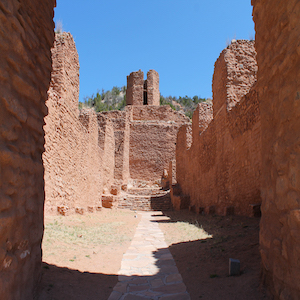
Annotation
The San José de los Jémez Mission is located near Albuquerque, New Mexico. It once belonged to a larger group of Spanish colonial churches along what is now the Us-Mexico borderlands. It was originally built in the early-seventeenth century to evangelize the native peoples, including the Jemez. Today, stone ruins remain. In the territory of modern-day New Mexico, Spanish friars struggled to maintain their rule over local communities and the stability of their settlements. The indigenous groups engaged in warfare with each other and with the church authorities, even killing some of the Spanish friars.
Misión San Miguel (New Mexico)

Annotation
The San Miguel Chapel was built between 1610 and 1625 as part of the Spanish Crown’s efforts to evangelize the native peoples of the Americas. Located in modern-day Santa Fe, this church complex aimed to convert the Tlaxcalan community under the supervision of Francsican friars, while coercing them into Spanish ways of life. By sponsoring these largely church-run settlements, the Spanish monarchs were also claiming territory along a sparsely-populated frontier zone in North America. Indigenous labor built the church, as evident in their work on the wooden ceiling beams. The chapel still functions today, making it the oldest functioning Catholic church in the US. In spite of having endured damage from military attacks, intentional fires, and natural disasters, some of its 17th-century walls remain standing.
Misión San Ildefonso

Annotation
The San Ildefonso Mission, once operated as a Spanish colonial church near Santa Fe, New Mexico. Its adobe structure was built with indigenous labor under the supervision of Francsican friars. The objective of this church complex was to convert the native communities to Catholicism and introduce them to Spanish ways of life. Throughout the colonial period, the Spanish Crown struggled to staff the governments it established in the Americas, given their immense size. To help stake out its claim over the territory that today makes up the US-Mexico border, the monarchs allowed missionaries to create and oversee settlements. This church was originally established in the early-seventeenth century, but it suffered from extensive military attacks and natural disasters. The structure that stands today is a replica of the eighteenth-century version, built in the mid-twentieth century.
Misión San Francisco de Asís

Annotation
Throughout the seventeenth and eighteenth centuries, the Spanish Crown authorized the founding of dozens of missions in the modern-day borderlands region of the United States. During this period, these territories were the frontier of Spain’s empire in North America, close to regions claimed by British, French, and indigenous groups. The San Francisco de Asís Mission was established in the late-eighteenth century with the objective of converting the native peoples and maintaining a tighter supervision over their lives. Built with indgenous labor, the structure is made of adobe and has been restored several times. It is located in Rancho de Taos, New Mexico.
Misión San Gregorio de Abó

Annotation
The San Gregorio de Abó Mission once operated as a site of Spain’s evangelization efforts in the Americas. As the Spanish crown expanded its empire throughout North, Central, and South America and the Caribbean, it encountered a major obstacle: a shortage of bureaucrats to run all of the governments it was establishing. One of the solutions to this problem was allowing missionaries to supervise settlements in areas that were located far away from secular authorities. The Franciscan friars that created the San Gregorio de Abó mission in the mid-seventeenth century were therefore accomplishing dual objectives: convert the native peoples (the Tompiros) and stake out Spain’s claim over the territory. Located in New Mexico, only ruins remain of the church complex.
Nuestra Señora de Purísima Concepción de Quarai

Annotation
This church complex was built in the early-seventeenth century as part of Spanish friars’ efforts to evangelize the native peoples. Yet within 50 years, the settlement stood abandoned as a result of natural disasters and sustained military attack from rival indigenous groups. Only ruins of its stone structure remain, located near Albuquerque, New Mexico. They provide a window into religious practices of this period, with the remains of both a Spanish-style church and a kiva (a meeting room used in some indigenous rituals) on the premises.
San Ysidro and San Buenaventura de Humanas (Gran Quivira)

Annotation
This church complex was established by Spanish Franciscan friars in modern-day New Mexico in the early seventeenth century. The Crown authorized the creation of several missions throughout this region with the objective of converting the native peoples to Catholicism. The target for these efforts at this mission were the Salinas Pueblos. However, this mission was occupied for less than a century because frequent natural disasters and attacks from rival indigenous groups made its living conditions untenable. Only stone ruins of its foundations remain.
Mission San Xavier del Bac

Annotation
Located in southern-Arizona, this mission was originally founded by Spanish friars in the late-seventeenth century. The church that stands today was built with indigenos labor in the following century. During the colonial period, the Crown authorized the establishment of many similar church complexes throughout the modern-day borderlands of the United States and Mexico. Its objective was to evangelize the native peoples, but it also had a practical purpose. Spain struggled to produce enough bureaucrats to staff the new governments created in the vast American territories that Spain claimed. Allowing missionaries to run the churches and run these communities helped the monarchs increase the Spanish presence in this frontier zone.
Misión San Cayetano de Tumacácori

Annotation
This church was founded during the late-seventeenth century, when the Spanish Crown claimed this region as the northern border of its empire in North America. Throughout this period, the monarchs of Spain allowed missionaries to establish settlements in the modern-day US Southwest in order to evangelize the native peoples. It also helped the empire stake its claim over the territories, which were otherwise sparsely populated. Unlike the churches founded in Texas and New Mexico, this mission was founded by Jesuits. Franciscan friars eventually took over after the king, threatened by their wealth and power, expelled the Jesuits from all of Spain’s territories.
San José de Guadalupe
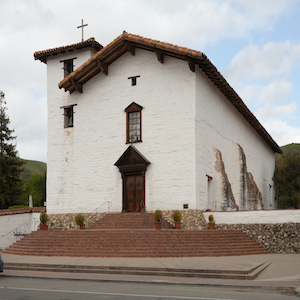
Annotation
This church was founded in the late-eighteenth century by Francsisan friars in modern-day Fremont, California. Their goal was to establish a settlement to evangelize the native peoples and coerce them into adopting Spanish ways of living, worshiping, and working. Although it joined a large network of similar missions throughout the borderlands region, it is one of the later-founded institutions. The church authorities struggled to maintain this control over the local populations, even facing rebellions. Environmental conditions also contributed to the instability of the region, with the frequent earthquakes. The building that stands today is a twentieth-century renovation.
Misión San Gabriel Arcángel

Annotation
Founded in 1771, the San Gabriel Arcángel Mission joined a large network of Spanish colonial churches throughout the territory that today comprises the Southwest United States. The Crown had granted the church permission to not only establish sanctuaries, but also to supervise local settlements in the hopes of converting the local peoples to Catholicisim. Its interior decoration still features some of the artistic work of these individuals. The church also has unusual architectural features (compared to the other Spanish missions established in the region during this period), borrowing from Arab cultures. It originally featured several warehouse buildings and a soldiers barracks.
Misión San Fernando Rey de España

Annotation
Throughout the seventeenth century and eighteenth centuries, the Spanish Crown approved the establishment of dozens of churches throughout the region that today comprises the US-Mexico border. During the period, this territory was the frontier zone for Spain, at the northern edge of its American colonies. Allowing the church to create these settlements helped the Crown stake out its claim in this otherwise sparsely populated area. It also encouraged the conversion of these communities to Christianity. Located in Los Angeles county, the San Fernando Rey de España Mission was founded 1797. Built with labor from the local indigenous communities, it featured a church, convent, and long colonnade. Throughout the early 1800s, it was home to a population of 1000 native peoples.
Misión San Rafael Arcángel

Annotation
Located near San Francisco, California, this mission originally functioned as a hospital. It was a secondary site for a larger mission closer to San Francisco. It was founded later than many of the colonial churches throughout the US Southwest, in 1817. These churches were built as part of the Spanish Crown’s efforts to evangelize the native peoples of the Americas. In addition to the hospital, the complex included a chapel, living quarters, and a storage area. After a fire in 1870, the structure did not survive. It was partially rebuilt in 1919.
Misión San Antonio de Padua

Annotation
The Mission of San Antonio de Padua was the third church established by Spanish friars in the territory that today comprises the state of California. Founded in 1771, this complex aimed to house the church authorities and evangelize the local native communities. Indigenous labor built the sanctuary and its supporting buildings, such as workshops and a granary. These institutions helped the Spanish Crown claim these territories as part of its empire because outside of the mission, the region was sparsely populated. The structures are stone and adobe, with the complex undergoing renovations and expansions over time. For example, a cemetery was added in 1804.
Misión Nuestro Señora de la Soledad
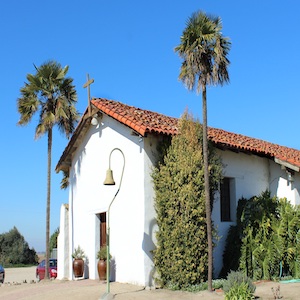
Annotation
Established in 1791, the Mission of Nuestro Señora de la Soledad was a Spanish colonial church in the frontier region of Spain’s empire in North America. By the time of its founding, twelve other similar institutions already existed throughout modern-day California, in addition to the dozens of churches across the US Southwest. The objective of these missions was to convert the native peoples to Christianity and teach them to live and work within Spanish culture. For example, under the supervision of the priests, the indigenous people raised cattle and sheep. The current structure has been restored, after having experienced significant damage from flooding.
Misión San Carlos Borromeo del Rio Carmelo

Annotation
Throughout the seventeenth and eighteenth centuries, the Spanish Crown granted its missionaries permission to establish dozens of missions throughout the modern-day US Southwest. During this period, this region was the borderlands between Spain’s territory and those claimed by the British, French, and indigenous groups. The Mission of San Carlos Borromeo del Rio Carmelo was the second one of these institutions established in California in 1770. It was built of adobe originally, but then replaced by a stone structure in 1797. Because of its early founding and location, this church complex operated as a central point in the network of California missions. It also had California’s first library (in 1778), with approximately 30 books.
Misión San Juan Capistrano (California)
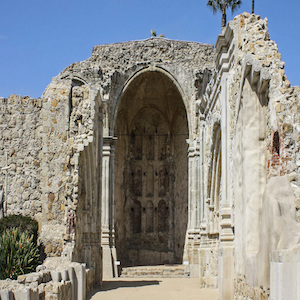
Annotation
Throughout the eighteenth century, Spanish friars established more than twenty Spanish colonial churches across the territory that comprises the modern-day state of California. This one, named the Mission San Juan Capistrano, was founded in 1776. These institutions aimed to convert the local peoples (the Acjachemen) to Christianity and teach them Spanish ways of living and working. It is located on the coast of California in the city of the same name, San Juan Capistrano, in between Los Angeles and San Diego. This source is part of the Historic Churches in the Southwestern US Source Collection.
Old Mission San Juan Bautista

Annotation
This historic church once belonged to Spain’s extensive network of religious institutions along the US-Mexico border. The Mission San Juan Bautista was founded in 1797, making it the fifteenth church established in modern-day California. The name of the church originates in its founding day, which was dedicated to the feast day for Saint John the Baptist. The complex aimed to evangelize the native peoples, and also stake out Spain’s claim over the land. Since it was built on the San Andreas fault, the church has suffered serious damage from earthquakes. It was restored in the twentieth century. This source is part of the Historic Churches in the Southwestern US Source Collection.
Misión Basilica San Diego de Alcalá
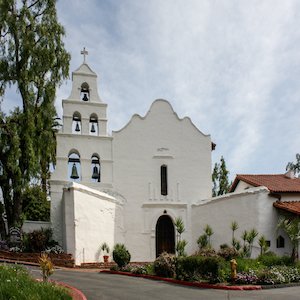
Annotation
Throughout the eighteenth century, the Spanish Crown authorized the establishment of more than twenty churches across the area that comprises the state of California today. These institutions, along with the dozens of other churches already founded throughout the US-Southwest region, aimed to evangelize the native peoples. This complex targeted the nearby Kumeyaay peoples. Founded in 1769, the San Diego mission was the first of the California missions. It originally featured orchards, vineyards, agricultural fields, and pasture lands. Because it suffered damage from fire, attacks, and natural disasters throughout its history, the complex was restored and expanded. This source is part of the Historic Churches in the Southwestern US Source Collection.
Old Mission San Luis Rey de Francia
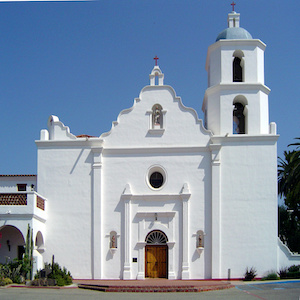
Annotation
Founded in 1798, this church belonged to the extensive network of Spanish colonial missions not only in California, but along much of the US-Mexico border. Through the eighteenth century, this region operated as the frontier zone between territories claimed by Spain, France, Britain, and indigenous groups. The objective of the churches established in this region was the evangelization of the local indigenous groups. For the Mission San Luis Rey de Francia, this included the local Takic speaking people. One of its identifying architectural features is its long colonnade, which runs in front of the convent on site. Like many of these missions, it featured a large courtyard and supporting buildings in addition to the sanctuary. This source is part of the Historic Churches in the Southwestern US Source Collection.
Misión La Purísima Concepción De María Santísima

Annotation
The Purísima Concepción Mission was founded in 1787 as part of a larger network of Spanish colonial churches throughout the region. By this time, ten other missions had been established in modern-day California, in addition to the dozens of others across the territory that today comprises the US-Mexico border. These churches aimed to convert the native communities to Catholicism by teaching them the scriptures and Spanish ways of living and working. In addition to the chapel, the complex originally featured housing units and other supporting buildings such as warehouses. Like many of the other colonial missions, the Purísima Concepción suffered damage over time from attacks and natural disasters, including earthquakes. Only ruins of the structure remain. This source is part of the Historic Churches in the Southwestern US Source Collection.
Misión San Francisco de Asís (California)

Annotation
Located near the modern-day city of San Francisco, California, this historic church was established by Spanish friars in 1776. It is also known as the Mission Dolores. Its cemetery, which houses the burial sites of indigneous individuals who lived, worked, and worshipped at this complex, remains largely intact from the eighteenth century. This church belonged to an extensive network of religious institutions throughout not only California, but across much of the US-Mexico border. Until the nineteenth century, this region comprised the frontier of Spain’s empire, near other territories claimed by Britain, France, and indigenous nations. The priests who ran the missions aimed to convert the native peoples in the area to Catholicism and teach them Spanish ways of life. This source is part of the Historic Churches in the Southwestern US Source Collection.
Misión San Luis Obispo de Tolosa
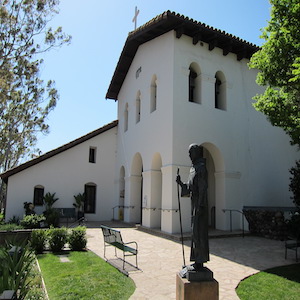
Annotation
This historic church was founded in 1772 by Spanish friars. Spain established dozens of churches throughout the US-Southwest region during the seventeenth and eighteenth century in an effort to convert the native peoples who lived there to Catholicism. These missions also helped the Crown stake its claim over the territory which was otherwise sparsely populated. By the time the San Luis Obispo de Tolosa Mission was created, there were four other missions in California alone. The structure (featuring the sanctuary, residences, and workshops) has undergone renovations over time to repair and expand the complex. This source is part of the Historic Churches in the Southwestern US Source Collection.
Misión San Miguel (California)

Annotation
The San Miguel California Mission was founded in 1797 by a Franciscan friar who was operating on orders from the Spanish Crown. Its namesake originates from the dedication of the complex to the Archangel Saint Michael. The goal of this church, and the dozens of other missions throughout the region, was to not only convert the native peoples to Catholicism, but also to teach them Spanish ways of living and working. This complex aimed to oversee the communities that the nearby San Antonio and San Luis Obispo missions were unable to incorporate. The structure has been expanded and restored over time. This source is part of the Historic Churches in the Southwestern US Source Collection.
Old Mission Santa Barbara

Annotation
This historic church complex belonged to Spain’s network of missions throughout not only California, but also across the region that today makes up the US-Mexico border. It was established in 1786 and named to honor the specific day of its founding (December 4th), which is dedicated to the Feast of Santa Barbara. By this time, California already had nine other missions in operation. Each of these institutions aimed to evangelize the native peoples who lived in the area, by coercing them to live, worship, and work at the mission. Like many of the other Spanish colonial churches in this region, it was created by Franscisan missionaries with permission from the Crown. Originally built of adobe, the structure has undergone renovations and expansions over the years. Earthquakes have been a major cause for such changes. This source is part of the Historic Churches in the Southwestern US Source Collection.
Misión Santa Inés
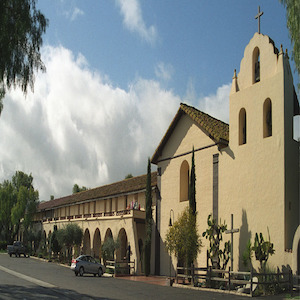
Annotation
Founded in 1804, the Santa Inés Mission was a church complex designed to convert the local native communities to Catholicism and teach them Spanish ways of living and working. By the time of its establishment, there were already eighteen other missions in California alone, in addition to the dozens of others throughout the modern-day US Southwest. Franciscan friars ran these complexes with the permission of the Spanish Crown. Except for some military outposts, these territories remained largely unpopulated by European communities. They were also frontier zones, near regions claimed by other (such as British, French, and indigenous) powers. In addition to the sanctuary, the complex featured residences, workshops, and an aqueduct. This source is part of the Historic Churches in the Southwestern US Source Collection.
Misión Santa Clara de Asís
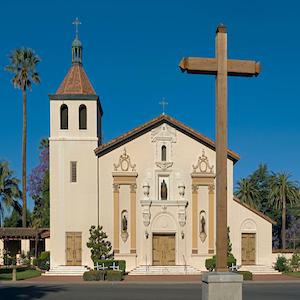
Annotation
Located today on the Santa Clara University campus in Santa Clara University, the Mission Santa Clara de Asís was originally founded in 1777. Like many other missions nearby, it was created by Franciscan missionaries with the permission of the Spanish Crown. These institutions aimed to convert the native peoples to Catholicism and teach them Spanish ways of life. They also helped the Crown stake its claim over the territory that today stretches across the US-Mexico border. In 1851, the Jesuits took over the church and established the first university in California. This source is part of the Historic Churches in the Southwestern US Source Collection.
La Exaltación de la Santa Cruz Mission

Annotation
Founded in 1791, the La Exaltación de la Santa Cruz Mission was a Spanish colonial church in Santa Cruz, California. The objective of this institution was the evangelization of the nearby indigenous communities. They included the following peoples: Ohlone, Costanoan, Miwok, and Yokuts. It was not occupied for long because of crimes committed in the settlement and attacks from the frustrated local populations. It remained the smallest mission in the area, in terms of population. Because of its turbulent history, the structure has undergone various renovations. The church in place today is a ⅓ scale of the original, built in 1932. This source is part of the Historic Churches in the Southwestern US Source Collection.
Misión San Francisco de Solano
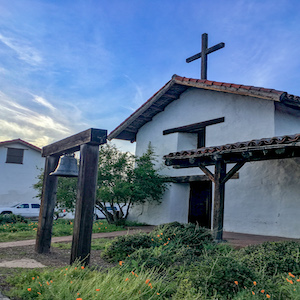
Annotation
Located in Southern California, the Mission San Francisco de Solano once operated as a Spanish colonial church. It was founded in 1823 and originally featured living quarters in addition to the sanctuary. Missions like this one were established to evangelize the native communities in the area. The Spanish monarchs approved the creation of dozens of missions throughout the borderlands region. The structure was restored in the early 1900s, and it is now a museum. To commemorate the lives of these indigenous groups, the current church has listed their names on a designated wall. This source is part of the Historic Churches in the Southwestern US Source Collection.
Old Mission San Buenaventura

Annotation
Known as the ‘Mission by the Sea,’ this church once belonged to Spain’s extensive network of missions throughout the modern-day US Southwest. It was founded in 1782 by Franciscan friars whose objective was the evangelization of the native peoples in the region, who were the Chumash. The church complex, which included aqueducts, was built with their labor. Under the church’s supervision, indigenous groups lived, worshiped, and worked on the premises. One of the main labors of the mission was the maintenance of its orchards. The structures have suffered from natural disasters over the years, ranging from fires to earthquakes. After each incidence of damage, even into the twentieth century, the church was renovated. This source is part of the Historic Churches in the Southwestern US Source Collection.










































